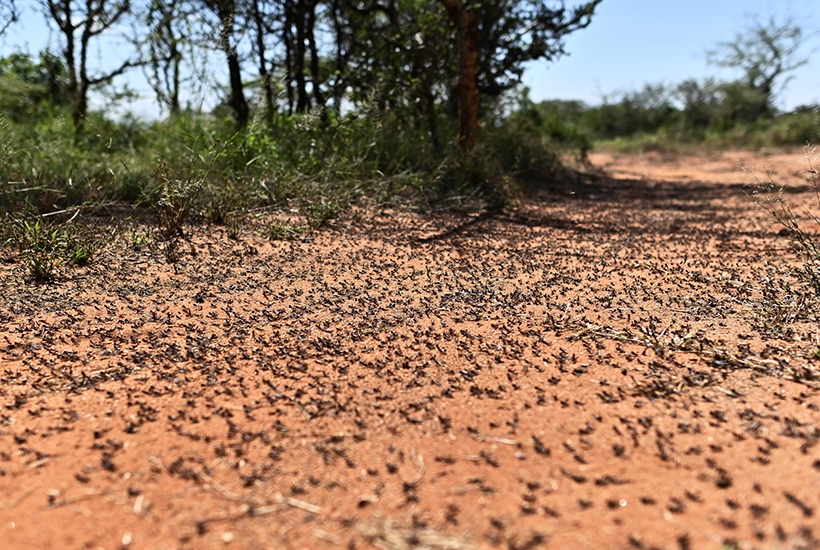As if 2020 hasn’t already scared the hell out of us all, a plague of locusts is upon us. When I first witnessed a swarm swirling across my farm in Kenya, it was hard to see them in the nightmarish way they’re depicted in Exodus or the Book of Revelation. They were millions of pink and golden Tinker Bell fairies, flying in a halo around the sun, filling the air with the sound of rustling skirts. But the breeding cycle of a locust is only a few months and they are growing in numbers exponentially. Soon, it’s predicted, we will see individual swarms equivalent to the size of London, each of which consumes as much food as half the population of the United Kingdom on a daily basis. In a variation on the theme of COVID-19, how this year of the locust arrived is a story of bad luck, human folly and cack-handedness — with ghastly consequences.
Like diseases, locust plagues have been a regular cause of famine in history. Last century there were some enormous outbreaks that spread across different parts of the world, inflicting widespread hunger. In 1954, swarms from Africa reached England and in 1988 even made landfall in the West Indies. Concerted international action in the post-war years progressively brought the problem under control and, as a boy in 1960s East Africa, I recall desert locust control officers were as common as traffic wardens. Their job was to roam the wilderness, monitoring solitary grasshoppers that every few years, on a pheromonic signal triggered by unusually heavy rainfall, suddenly began congregating in ever larger bands to lay their eggs in wet, sandy riverbeds. After hatching, the flightless hoppers would begin massing — at which point locust control teams flattened them all with poisonous sprays. In the decades following the end of empire, locust swarms were rarely seen, existing mainly as a story of the bad old days before clever scientists came to the rescue.
In late 2018, locusts began multiplying in Oman’s Empty Quarter desert, following heavy rains from the super-sized Cyclone Luban. These days it’s the job of a United Nations agency called the FAO — the Food and Agriculture Organization — to lead global locust control efforts. Yet in this case the FAO, which is as feckless as the WHO during pandemics, completely failed to stop the locust populations metastasizing across Arabia. Taking wing on the monsoon winds, swarms soon crossed into Yemen, where even if the FAO had wanted to deploy, access was impossible due to the civil war pitching multiple extremist groups and Middle Eastern states against each other. From there, the insect hordes crossed the ‘Strait of Tears’ into the Horn of Africa, where they found secure lodgings in Somalia, another failed desert state, where the jihadi group al-Shabaab controls much of the territory. Last year, as the locusts went through several more breeding cycles and began spreading into Ethiopia and Kenya, the UN and sundry African organizations funded by western taxpayers realized it was time to act. Naturally, they declared an emergency and urged rich countries to send large sums of cash.
As soon as the money arrived in Africa, it was pilfered. Powerful, politically connected men set up aviation companies and scored contracts to spray against locust swarms — only not much spraying got done. Meanwhile, as the world recovered from its New Year hangover this year, the locust swarms in eastern Africa got ever larger, with individual mobs covering 19 sq km. The swarms made an impressive sight, murmurations of billions of insects, showing up black against the horizon and then silver as their filigree wings caught the sunlight in unison. The numbers became so great that when they roosted in acacia trees, the creatures landing on top of each other caused branches as thick as a man’s torso to snap off. In southern Somalia, panicked militias opened fire on the flying insects with anti-aircraft guns and exploding rockets. But the locusts kept breeding and eating.
Due to a weather system across the Indian Ocean, while this year kicked off with bush fires across drought-stricken Australia, excessively high rains lashed East Africa, creating more perfect conditions for the locusts to multiply. The FAO finally got its act together and is now doing a pretty good job, using crop-spraying Air Tractors to drop mists of deltamethrin, an insecticide you might be familiar with if you have an apple orchard. ‘They’re hard things to kill,’ says Mark, my crop-farming neighbor north of Mount Kenya. ‘An hour after being sprayed a few days ago they all fell off the trees. Then three days later they all got up and flew away.’ One swarm landed on his wheat fields and gobbled up 125 acres of young crops within minutes. The locusts tend to scorn the rough pastures of my cattle ranch, or the acacia forests of the wilderness. What they’re after is carbohydrates to fuel their bodies on migrations of up to 93 miles a day.
Until now, most of the swarms have been breeding in remote desert areas inhabited mainly by livestock herds. But in the current rains across East Africa, they are now massing to invade agricultural areas just as the staple crops such as maize ripen. They will probably even reach the tea estates of western Kenya, where your PG Tips is grown. The global COVID-19 crisis has interrupted operations to import deltamethrin and spray the swarms so comprehensively that they are killed off before spreading ever more widely. Ideally, you want to destroy the insects at the egg or hopper stage — but it’s too late for that. It’s a sad sight watching the Air Tractors valiantly chasing swarms of adult locusts, which morph from bright pink to golden yellow as they reached their final instar stage of life when females each lay hundreds of eggs. There are now far too many adult insects multiplying for the planes to tackle. Forecasts are that by June or July the swarms will be 400 times the size they currently are. Catching a ride on the winds, they are migrating out of Kenya, heading across south Sudan and out towards the badlands of West Africa, where Boko Haram and other al-Qaeda affiliates will make it almost impossible to kill the locust advance. By mid-summer they will have arrived at the Atlantic and perhaps they’ll reach the beaches of Cornwall again. Meanwhile, other locust armies are heading east across Afghanistan. Pakistan declared an emergency in February, long before the coronavirus panic. By the end of 2020, many of these countries, struggling to cope with the economic effect of the virus pandemic, will be facing not recovery, but another plague.
This article was originally published in The Spectator’s UK magazine. Subscribe to the US edition here.


















